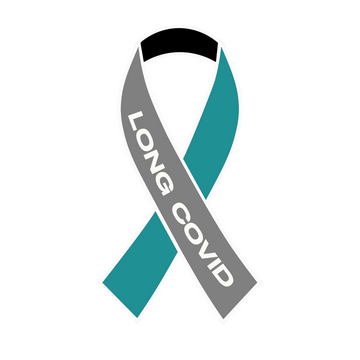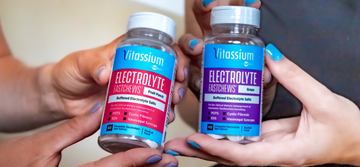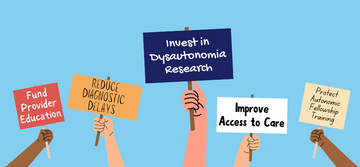
This article is written for educational purposes only and should not be construed as medical advice. If you are experiencing symptoms of Long COVID or dysautonomia, including chronic fatigue, lightheadedness, rapid heartbeat after standing or minimal movement, and/or brain fog, talk to your doctor.
This article was last updated on March 15, 2023.
In February 2020, Amanda’s husband fell ill after traveling for work, complaining of a high fever and trouble breathing. Four days later, Amanda got sick as well.
With concerns of the novel SARS-Cov-2 virus spreading rapidly, their primary care physician refused to see them, so they found themselves in an emergency room. All tests for strains of the flu and strep throat were negative.
They were never tested for the novel coronavirus as testing kits were extremely limited at that time, but Amanda had little doubt she and her husband were early COVID-19 patients. She had all the symptoms: fever, trouble breathing, loss of taste and smell, extreme fatigue.
Her husband’s situation improved. Hers didn’t.
“At the end of March, I unfortunately was developing new symptoms that were very strange – tachycardia, passing out when I stood up, allergies to foods I had always [eaten], and strong aversion to any smells,” Amanda said. “After I gained my sense of smell back, it seemed that all smells were just too strong, especially anything that contained a synthetic fragrance.”
She also seemed to be constantly dehydrated. Blood work indicated low sodium levels, but her doctor couldn’t offer a cause for these long-lasting symptoms, suggesting she may just be imagining them.
Amanda refused to accept this conclusion. Her mom, a nurse practitioner, said her symptoms sounded like POTS (Postural Orthostatic Tachycardia Syndrome) and told her to try and meet with a cardiologist. Amanda did, and one tilt table test later, she received her diagnosis. It was POTS, likely triggered as an autoimmune response to her probable COVID-19 infection, the doctor said.
What Is Dysautonomia?
To anyone living with autonomic nervous system disorders, or dysautonomia, Amanda’s story – from her symptoms to her setbacks in the diagnosis process – may feel familiar.
Thought to affect more than 70 million people worldwide, dysautonomia is a medical term that represents a malfunction of the autonomic nervous system. This system controls the “automatic” functions of the body that we do not consciously think about, such as heart rate, blood pressure, digestion, dilation and constriction of the pupils of the eye, kidney function, and temperature control. People living with various forms of dysautonomia have trouble regulating these systems, which can result in lightheadedness, fainting, unstable blood pressure, abnormal heart rates, and malnutrition.
There are several forms of dysautonomia, including POTS, as well as neurocardiogenic syncope (vasovagal syncope), inappropriate sinus tachycardia (IST), and multiple system atrophy.
Despite the high prevalence of dysautonomia, most patients take years to get diagnosed due to a lack of awareness among the public and within the medical profession. For instance, 59% of POTS patients were told by a doctor that their symptoms were “all in your head” before receiving their diagnosis, according to Dysautonomia International.
Dysautonomia can have multiple causes, but viral infection is a known trigger.
What is Long COVID?
“Long COVID” is an umbrella term for the long-term health effects that may happen after SARS-CoV-2 infection, such as organ and tissue damage that can occur during the acute infection, inflammation, autoimmunity, coagulation problems, or other complications, said Lauren Stiles, president of Dysautonomia International and research assistant professor of neurology at Stony Brook University School of Medicine.
The type, severity, and duration of symptoms can vary widely. According to the U.S. Centers for Disease Control and Prevention (CDC), the most commonly reported symptoms include:
- General symptoms like fatigue, post-exertional malaise, and fever
- Respiratory and heart symptoms like difficulty breathing or shortness of breath, cough, chest pain, or heart palpitations
- Neurological symptoms like brain fog, headache, sleep problems, dizziness or lightheadedness (especially upon standing), pins-and-needles sensation, changes in smell or taste, or depression or anxiety
- Digestive symptoms like diarrhea or stomach pains
- Other symptoms like joint or muscle pain, rash, or changes in menstrual cycle
Is Long COVID actually dysautonomia?
Often, Long COVID is compared to one of the most common forms of dysautonomia – POTS – due to orthostatic intolerance. In fact, POTS is currently the most common post-COVID diagnosis, according to Stiles, although Long COVID can also cause other types of dysautonomia. According to a study published in April 2022, to which Stiles is a contributing author, 67% percent of people with Long COVID have developed “moderate to severe” dysautonomia.
That said, research is still preliminary, and many studies have examined small groups of patients with minimal diversity. This means there is still a lot we don’t know, and it’s too early to draw conclusions about what’s going on with COVID-related dysautonomia – or standardized treatment guidelines. (Even when researching this article, our team noticed terms like “POTS” or “dysautonomia” were used in different ways, depending on the article.)
Who is more likely to get Long COVID?
Research is ongoing to determine who may be more likely to develop Long COVID and why. Based on what we know so far, the following groups of people may be at higher risk, according to the CDC:
- People who have experienced more severe COVID-19 illness, especially those who were hospitalized or needed intensive care.
- People who had underlying health conditions prior to COVID-19.
- People who did not get a COVID-19 vaccine.
- People who experience multisystem inflammatory syndrome (MIS) during or after COVID-19 illness.
Can Long COVID be prevented?
While there is no surefire way to prevent Long COVID, the CDC recommends doing what you can to avoid being infected with COVID-19, like staying up to date on vaccinations against COVID-19, improving ventilation, testing as-needed, avoiding contact with people who may have COVID-19, practicing good hand hygiene, and seeking treatment if you are infected with COVID-19.
Studies have shown vaccination against COVID-19 can help lower a person's odds of developing Long COVID even if they experience a breakthrough infection. Vaccination has also been shown to help reduce the severity of symptoms and lower the risk of hospitalization.
How is Long COVID treated?
There is no one-size-fits-all approach to Long COVID treatment, according to Stiles.
If a patient has POTS or another type of dysautonomia as a result of Long COVID, treatment options remain the same as for other dysautonomia patients. This can include increasing fluid and salt intake, wearing compression garments, using disability aids, raising the head of your bed, eating small low carb meals throughout the day, avoiding triggers like heat and excessive standing, and doing exercise specifically designed for people with dysautonomia. Vitassium provides a boost of sodium and potassium to help manage symptoms of low blood pressure, fatigue or lightheadedness, in whatever format works best for you.
What to do if you are experiencing long-lasting COVID symptoms
If you or someone you know has had COVID-19 and now has ongoing symptoms like the ones listed above, you should discuss them with your doctor. Your doctor will likely try to rule out other potential causes of your symptoms that would require different treatments.
If you suspect you have dysautonomia, you can ask your doctor to perform orthostatic vitals, also known as an active stand test, where your blood pressure, heart rate, and oxygen levels will be measured while you’re lying down, sitting, and standing. This is often the first step to diagnosis.
Remember, it’s NOT all in your head! Although awareness is improving, conditions like POTS are often misunderstood by healthcare providers, and can unfortunately be dismissed as anxiety. Dysautonomia International has a list of patient advocacy tips.
If you’ve had significant physical changes in the way your body feels and behaves, whether due to COVID-19 or not, it’s important that you seek treatment. These tips from the CDC can help you explain your symptoms to your doctor. Survivor Corps also has a list of post-COVID care centers and “COVID-friendly” doctors in the U.S. and other countries.
What’s next?
There is still a lot more research that needs to be done around Long COVID and its similarities to forms of dysautonomia like POTS, but research on Long COVID is evolving faster than research on any disease in history, according to the Long COVID Research Fund.
For Amanda, it means taking things one day at a time. “I still have symptoms of POTS but not as severe,” she told us in November 2020 – nine months after her initial infection. “I am able to walk my dogs and go to the store without being scared if I will pass out.”
“Some days I just feel so fatigued and tired of fighting, but I keep going somehow,” she said. “I am not giving up.”
Disclaimer: Contact your physician before starting any exercise program or if you are taking any medication. Individuals with high blood pressure should also consult their physician prior to taking an electrolyte supplement. Overdose of electrolytes is possible, with symptoms such as vomiting and feeling ill, and care should be taken not to overdose on any electrolyte supplement.







